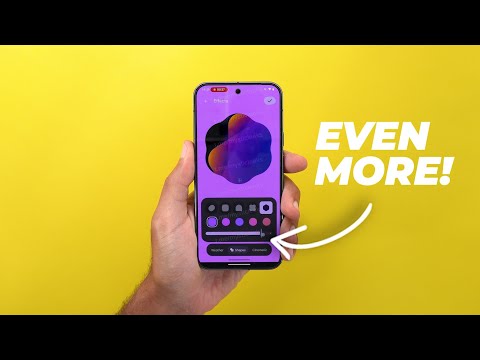
If you saw the new Android 16 changes Google recently revealed in the Android show, let me tell you that this is just a fraction of what's coming. Today, I will show you tons of new changes from multiple sources that might come to Android 16 over time, which made me even more excited about this new release. So, without further ado, let's jump in. Let's begin with the lock screen. If Android 16 lock screen customization page is going to match this Mystic Leaks video shared on Telegram, I will be really impressed.
First, the layout makes more sense than what we have right now. Currently, the available options are scattered across the screen, while in this leak, it's simpler and better organized. You will first see the wallpapers carousel, which I hope it will be smaller in the official release. Then, a swipe up will minimize it and reveal the rest of the options. Under the clock page, Google moved everything to the bottom, similar to what we have seen in 1 UI and the iOS, which I like. There are two different designs revealed by Mystic Leaks. The older one that you see here also matches what Android authority revealed. It includes two tabs, one for the style that also includes a toggle for the clock size and one for the color. So far, the functionality is the same as Android 15, but only the default clock gives you the option to do further edits to the font, like adjusting the weight, the width, and two more toggles to make it rounded and slant.
But as per Mystic Leaks, Google removed this editing page and replaced it with one toggle that adjusts the weight and width al together with a third tab dedicated for the size. Either way, I'm happy to see Google giving extra attention to this area to be on par with the competition. The next big thing is the new effects panel that I think is so cool. It includes three tabs starting with the shapes. Here you can choose between five different material you designs. What happens here is only this portion of your wallpaper will appear with the rest of the page in a solid color that you can change and adjust its brightness too. The end result looks very nice and I like how it animates. Moving to the weather tab. I'm not sure what the local option exactly means, but being able to add these gorgeous weather animations to the lock screen and adjust the intensity is certainly a welcomed addition. Of course, we've seen this before with One UI, but late is better than nothing.
And lastly, the cinematic tab that includes the 3D motion effect, which we already have in Android 15, but with a fresh new look. This will take us to customizing the lock screen shortcuts, which also got a new look when compared to what we have now. There is no evidence of third party apps support like 1 UI and iOS, but we might see two extra toggles for keep notes and the thermometer app.
I expected third party apps support and more toggles, but so far that's all we got. Under the notification settings, we expect to see a new option called compact that only shows the app icons rather than the full list. And here's a side-by-side comparison between the two. Beside the visuals, there are a lot of other functional changes that Pixel UI lacked for a very long time. For example, in this video by Mashar Rahman, we've seen the lock screen widgets in action. It still looks barebones, which is expected, but I like the fact that the widgets have their own page, which gives more room to add extra items, unlike the tiny spaces available in 1 UI and iOS. Additionally, a flag is spotted in Android 15 QPR1 beta 2 that enables the Gemini button on the lock screen.
This could be another way to trigger Gemini as if we don't have enough. The long- awaited double tap to lock the screen was successfully activated by Meshar Rahman in Android 16 beta 4, which I'm glad to see. Android 16 might also prevent sensitive notifications from showing their content regardless of your notification settings. For example, if you decided to show sensitive content on the lock screen, notifications like OTP codes will remain hidden, which is a great security measure. Overall, these new changes address most of the gaps I mentioned in my previous video about Google's version of Android and why it lags behind the competition. So, as a long-term Pixel user, I would be really happy to see them coming. Now, let's talk about the home screen. Obviously, the home screen customization page got the same redesign as the lock screen. The biggest change here is the ability to change the app icon shapes under a new menu called app shape and layout.
That also includes the grid size menu, which I will show you in a minute. As demonstrated in this video, you can choose between six different material use shapes. And here's a quick look at the layout tab, which doesn't offer anything new, but it looks a little bit better. The app drawer might also see some tweaks. It got this new floating card design that leaves some space for the status bar with a handle at the top rather than covering the entire screen like what we have now. I like this new change as currently every time I pull the app drawer, the status bar icons keep changing from white to black and vice versa, which is a bit annoying. Additionally, Mystic Leaks and the Android Authority shared some new changes in the animations. Starting with the folders, you will notice here that the home screen zooms out and becomes slightly darker when you open a folder instead of the static flat look we have right now. And the animation is more bouncy, which is the trend with Android 16.
The app close animation looks different as well. It's more bouncy and the blur effect is more intense when compared to Android 15. And here are a couple of videos from the two sources showing a new animation for the power button long press that briefly squeezes the screen before triggering the action. Plus, Gemini animation now shows a wide glare instead of dimming the background like on Android 15. Moving to the recent apps screen, the first change is the app icon got replaced with a pill-shaped bubble at the top left corner with a drop- down arrow that makes it more obvious that there is something hidden underneath it with a cool new expand and collapse animation. And lastly, as per Masaran, foldables and tablets might show the most recent apps in the task manager rather than the suggested ones like what we have now. This might give a more consistent experience instead of relying on what the system suggests for you. Overall, all the home screen leaks are mainly visual, and I didn't see any of the features I hoped for, like the home screen pages reordering or hiding, apps, multi selection support, and an easy way to hide apps, which I hope to see coming somewhere in the future.
Now, let's talk about the quick settings. Beside what Google showed already, we might see an updated media output switcher that matches the new design language with an updated volume slider. I also prefer this new layout because it makes more sense to have the connect device button front and center instead of scrolling all the way down to reach it. A new video chat tile has been spotted to adjust some settings for video calls like improved lighting, portrait touch-up, studio style mic, and adjusting the background blur from light to full. As per Mishar Rahman, this one is expected to work with different video chatting apps, which is very handy instead of digging into the settings for each one to do the same.
And lastly, we already know what the status bar will look like as revealed by Google, but in another leak by Mashar Rahman, we might see a colorful battery icon that it changes between green, white, and red based on the current state as shown here. Overall, I'm happy with the leaked and confirmed the changes we've seen in the quick settings so far. They give a fresh new look and better utilize the available space. If you reached this point of the video, it's worth checking the channel's wallpapers by in-depth thick reviews app. You will find a lot of greatl looking wallpapers to choose from with a separate editing panel for the lock and home screens to give you more control over the look of each one. You will find Google Play Store download link in the description. Now, let's talk about the notifications. Beside the fresh new look of the notifications sheet, there are a lot of other features spotted in the leaks like the bundled notifications.
The description says notifications with similar themes will be silenced and grouped together for quieter experience. Bundling will override an app's own notification settings. The screenshot reveals four different categories: promotions, news, social, and recommendations. A feature like this will certainly minimize unwanted distractions. Talking about distractions, blocking old notifications is another feature to help with the same. The system now rejects notifications that are more than 2 weeks old. These older notifications will only show some details to let you know which apps and contacts to check up on, but they will no longer alert you with a sound or vibration or even show the full content of the notification. So, if you have an old phone that you haven't used for a while, this feature will control the notification flaw that arrives whenever it boots up. Another feature copied from iOS is the notification summaries. Unlike Apple's version that summarizes everything, this one states that it will only summarize conversations, but apps have to specifically designate their notifications as conversations for the feature to work.
And the last one I'm going to talk about in this chapter is the bubble notification stashing, which will allow you to stash bubble notifications to the side of the screen when not in use. Similar to the picture and picture window, overall the notifications might get a lot of great features that will make the already great Android notification system even better. Now it's time for multitasking, which is expected to get a lot of new improvements. The most exciting change is the ability to open any app in a floating bubble on phones and tablets.
Once the feature is activated, Pixel Launcher adds a bubble button to the context menu that appears when you long press on any app on the home screen. Tapping this button opens the app in a floating bubble. The open apps will be consolidated into a bubble bar to switch between them with the ability to dock it to either side. Tapping the top handle will reveal the app context menu that also includes the ability to switch to full screen view. This feature is available for ages on one UI and other Android skins. So, I'm glad to see it making its way to Pixel UI. Moving to the split screen, currently you can display two apps side by side either in a 50 to 50 or 70 to 30 ratio, but Android 16 might add a new 90 to10 ratio.
This one is ideal for focusing on one app while keeping the other open for reference. Tapping the smaller app should instantly enlarge it, which gives you more flexibility on smaller screens. On bigger screens though, we might get the ability to run three apps side by side. Two apps share 90% of the screen and the third occupies the remaining 10%. The third app might be too small to work with, but with a single tap, you will be able to expand it whenever needed and keep it aside when not in use, which will make it easier to reach rather than manually locating the app every single time. One more feature that might come to tablets is the quick access to the keyboard shortcuts menu which will list all the available options with the ability to search.
Desktop mode is another way to elevate your multitasking experience which we've seen with Samsung Dex for years. Google seems to be working on a proper desktop mode that works pretty much the same as your PC. It has a dock, navigation buttons, access to your quick settings and notifications, the ability to open multiple apps at the same time and freely resize them on the screen or dock side by side. In addition to the ability to drag and drop text and other items between apps, which is very handy. There is no confirmation as of when this feature will be available, but at least we know it's in the works. Additionally, Google is testing new external display management tools in Android 16 that bring Android closer to other desktop oss. It will enable mouse cursor transitions across connected displays, adding the ability to rearrange them to match their physical locations, and the auto toggle to switch between mirroring or extending. All these features will take Android's desktop mode to a whole new level, which I'm excited about.
Now, let's talk about the other tweaks, and I will start with the settings app. The new design could bring material design 3 toggles. When it's turned on, it will show a check mark and an X when it's off. Each item is separated in individual cards with arrows to indicate when subpages exist. And when you open any page, the header is collapsed by default to show more items at a glance with the back arrow surrounded with a circular container unlike before. And for reference, here's a side-by-side comparison with Android 15 to see the differences between the two. I personally like this new change. It makes the settings app look more organized and well put together. But it's not only about the looks. We might see some useful settings coming in the future like the ability to force dark theme on apps that don't support it using this new to a new time zone change feature that will appear under settings system date and time. The description says that this feature will let you receive a notification when your time zone is automatically updated.
The extra dim feature is getting some tweaks as well. First, it will be renamed to even dimmer. And when activated, the system will automatically make the screen dimmer when you push the slider all the way down without the need to toggle the feature every single time. So, in other words, adaptive brightness will automatically dim the display further when the environment is dark and the slider is set all the way down. So, that's it when it comes to the settings. Now, let's talk about some random tweaks here and there. Here's how the new volume slider and panel will look like. They follow the same design language Google revealed. On a side note, we might see this tiny waveform that appears when you play media, which looks nice. Another small yet great addition to the screen recording and casting is the ability to switch between apps, even if you initially selected the single app option.
This notification should appear when you change apps, giving you the option to switch to the current one without the need to restart your session, which is very handy. And lastly, the screen saver. Currently, Android 15 offers two ways to trigger the screen saver. either while charging or while docked. The problem here is the screen saver gets triggered when the device is laid flat which is not ideal during the day. With Android 16, Google could introduce a new screen saver trigger called postured which requires the device to be sitting upright not flat. So that was everything expected to come to Android 16. If all these features didn't make you excited already, I'm not sure what can. I'm eagerly waiting to try all these features and visual changes when Android 16 gets released. sometime next month. So, please let me know in the comments what you think about the upcoming version.


